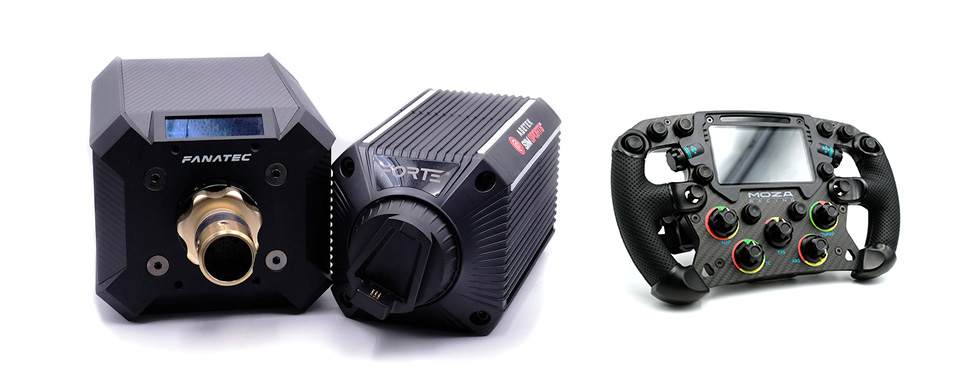The 5 most common mistakes when buying sim racing hardware
Almost everyone has already got their simracing purchases wrong or regretted a purchase afterwards. It wasn’t always the product itself that was the deciding factor, but often the circumstances or the timing of the purchase. We regularly receive feedback by email and have listed and categorised the five most common mistakes when buying sim racing hardware.

1 – Do not pay attention to compatibility


By far the most common mistake is buying non-compatible hardware. Especially if you come from a complete set like Logitech G29 or Thrustmaster T300, the simracing market can seem very confusing at first. Many manufacturers now have more or less closed ecosystems that are rarely fully compatible with each other. The most frequently mentioned points related to the following points:
- Most products are not compatible with a PlayStation or Xbox. If it is not explicitly stated, it can be assumed that a simracing product can only be operated on a PC.
- To operate third-party steering wheels on a Fanatec base, you need a Podium Hub, CSL Hub or ClubSport Universal Hub.
- Simucube Wireless Wheels cannot be operated via the home WLAN network. A compatible Simucube base is absolutely necessary. The same applies to the wheels from Moza and Simagic, for example).
- Most rigs with mounting plates for the steering wheel and wheel base have a few pre-drilled holes. However, products from niche manufacturers in particular are often not covered. You then have to drill the holes yourself.
- Screws and other mounting materials: Manufacturers often pass the responsibility on to each other and do not supply the required range of screws in different lengths in case of doubt. This can lead to unwanted delays during commissioning, especially when installing a wheelbase. Simracers should therefore keep a stock of the most frequently required screws if they want to regularly install new hardware and tighten screws on the rig. The same also applies, with restrictions, to tools. (Tip: M2-M6 screw set, Wera offset spanner set)
2 – Prioritising the wrong things
Many simracing setups are very unbalanced. Be it high-end hardware on a desk or a T150 mounted on a motion simulator. It is important to find a certain balance here. For example, if you have a maximum budget of €1000 for the foreseeable future to upgrade from an entry-level setup, a mid-range direct drive set probably makes more sense than investing the money in high-end pedals without upgrading the rest of the hardware.
In general, the importance of a stable rig should not be underestimated and should always be kept in mind when upgrading. There is no magic formula for the right sequence of upgrades, but targeted upgrading is the best way to avoid unnecessary purchases. The second-hand market can also be a very good additional help here to minimise losses on the way to a high-end setup. If you also pay attention to the remaining warranty and collect the hardware locally, the risk of buying second-hand is almost negligible.
3 – Sticking with cheap hardware for too long / starting with a high-end setup
The third point contrasts two common mistakes that could hardly be more contradictory. Many sim racers hold on to their entry-level hardware forever and sometimes put off an upgrade for years. Once upgraded, the reaction is often along similar lines: “If only I had upgraded earlier, wow that’s awesome!”
On the other hand, there is the opposite extreme of beginners who sink thousands of euros into their initial equipment without even having tried sim racing once. As tempting as it may be, freshly purchased setups can always be found for sale on eBay and similar sites. Simracing was often simply not the right hobby for these people and it would have made more sense to buy the classic starter set first.


4 – Being wrongly influenced / hype about hardware
Even if these words may sound wrong on a website that often does just that: As a buyer, you shouldn’t always be influenced by the latest videos, articles and reviews. Not every new piece of hardware is the best and you should be wary of creators who want to sell video after video of every piece of hardware as the new highlight on the market. It can also never hurt to get opinions from customers themselves as well as from various sources via reviewers and the like. However, there are hardly any really extremely bad simracing products in the upper price segment. Following your own instincts (or even better: testing the hardware yourself at trade fairs or with other simracers) often does no harm and is better than blindly buying the latest hype product.
5 – High expectations
Point five goes hand in hand with point four. Videos, reviews and the like often raise very high expectations of new sim racing hardware, which cannot be fulfilled. This applies both to the products themselves and to the effects on lap times. Many users believe that expensive hardware also makes them faster. In practice, however, this is often not the case and the disappointment afterwards is correspondingly great.
But expectations don’t always match reality either. A steering wheel for €150 can creak and buttons can make noises when shaken. Even Alcantara or leather no longer look like new after months. A healthy expectation of hardware with a certain price is required here.











